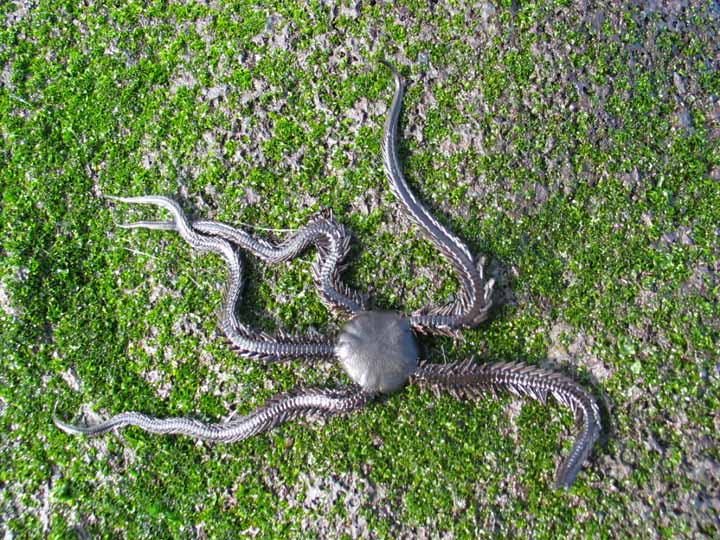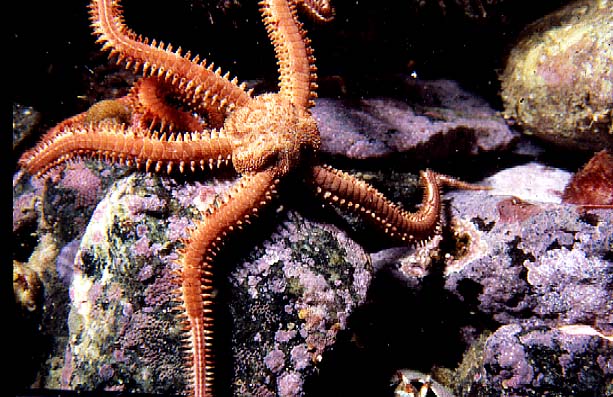Ophiothrix spiculata is a common species among algal holdfasts at Race Rocks. Its arm’s spines are especially long, and each one has a number of small thorns on it. the color is extremely variable but it is generally reddish brown, there may be some orange on the disk, too. in spite of all the color variation, this species is unmistakable because of its thorny spines.
Two sets of video on brittle stars are seen here. They were observed off the docks at Race Rocks in about 10 meters of water. Note the other organisms that live in the area also.
This brittle star is lives on the rocky sea floor, from shallow waters to great depths. Brittle stars are related to sea stars. These marine invertebrates move very slowly along the sea bed. More than 2000 species of brittle stars exist in the world.
It has long, thin, spiny arms that radiate from a flat central disk; the arms do not touch each other at their bases. Many of the arms are forked. If a brittle star’s arm is cut off, it will regenerate.
Usually the central disk in these brittle stars is under 2 cm) in diameter. They have an exoskeleton and vary in color. They do not have a brain; they have a simple ring of nerve cells that moves information around the body. Tube feet located along the arms sense light and smells.
This juvenile brittle star was filmed in the lab by Sylvia Roach using a Digital camera attached to a dissecting microscope at 4X
Domain Eukarya
Kingdom Animalia
Phylum Echinodermata
Class Ophiuroidea
Order Ophiurida
Family Ophiodermatidae
Genus Ophiothrix
Species spiculata
COMMON NAME: brittle star
They often gather in large groups and collectively filter food from the circulating water. When roused from a hiding spot their best form of defense is to crawl away-
The projections on the five arms of this brittle star look like many tiny hairs, but are actually spines. That being said, they are gentle, very delicate creatures that do not harm humans. They are nocturnal (feed and move about primarily at night); they stretch out to catch food particles, passing the bits down to the central mouth.
To avoid predation, if a predator catches one of its legs, it has the ability to swim off, leaving that leg behind, and it can regenerate a new one!
Waving arms point out the home of the stars. Those aren’t worms, they’re brittle stars, sea star cousins that hide themselves under rocks and in the holdfasts of kelp, especially in the Pterophyga at Race Rocks.
 For comparison with another species, see this image in our ecological equivalents file an image of a large 20cm species from the Galapagos:
For comparison with another species, see this image in our ecological equivalents file an image of a large 20cm species from the Galapagos:
Reference Cited:
Eugena N. Kozloff , Seashore Life of the North Pacific Coast
http://www.mbayaq.org/efc/living_species/default.asp?hOri=1&inhab=142
| Other Members of the Phylum Echinodermata at Race Rocks |
and Image File |
 The Race Rocks taxonomy is a collaborative venture originally started with the Biology and Environmental Systems students of Lester Pearson College UWC. It now also has contributions added by Faculty, Staff, Volunteers and Observers on the remote control webcams. The Race Rocks taxonomy is a collaborative venture originally started with the Biology and Environmental Systems students of Lester Pearson College UWC. It now also has contributions added by Faculty, Staff, Volunteers and Observers on the remote control webcams.
March October 2003- Rahilla (PC) |

